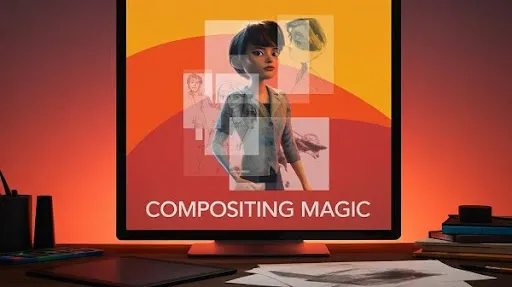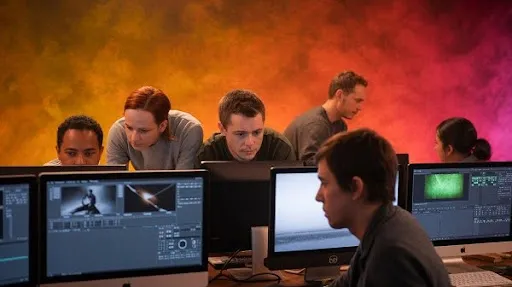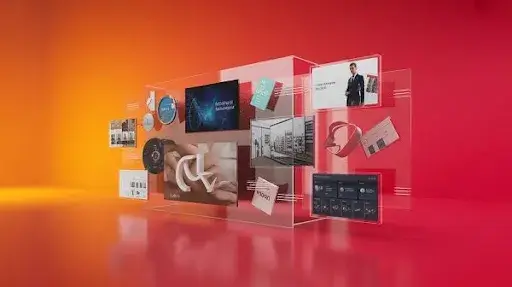When you watch an animated film or a TV commercial, you see a polished final product. What you don’t see is one of the most important steps that gave it that polished look: compositing in animation.
It’s the stage that makes frames feel connected, lighting look consistent, and effects blend without standing out awkwardly.
By 2025, this facility will stand as a titan in the animated-post-production world. Improved software and streamlined workflows now render the process both quicker and indeed more intuitive.
To appreciate the evolution, let’s first clarify the fundamentals: what compositing in animation really means and its crucial role in establishing a finished piece.
What is Compositing in Animation?
At its core, compositing centralizes the gathering of disparate elements into a single, convincing frame. 3D assets, scanned live-action plates, digitally painted backdrops, intricate FX, and the occasional scanned cel drawing can all find a home in a single composite.
Inside a 3D animation studio, scenes are almost never rendered in a single go. They’re split into render passes. Lighting, shadow, texture, and reflection all output as individual layers.
When it’s time to composite, those separate elements get merged and transformed into the master sequence everyone uses.
The goal, however, surpasses mere layering; the intent is to create a single cohesive environment in which all pieces convincingly coexist. Bypass this function, and the footage remains raw and unconnected, revealing the seams that illusions depend on the viewer to suppress.
Compositing in 3D Animation
The term itself came from photography, but compositing in 3D animation is its own beast. By layering passes, an artist gets control over every small detail of a frame. A light can be brightened. A shadow can be softened. A glow can be added to highlight an object—all without re-rendering from scratch.
This saves massive amounts of time. Rendering a 3D sequence isn’t quick. It can take hours or even days. Compositing gives studios a way to make fixes without restarting the whole render.
It also opens the door to adding elements of 2D animation services inside 3D projects. Think smoke, sparks, or motion blur. That blend of 2D and 3D gives scenes a sense of depth while saving both time and computing power.
Fact: Animated movies are experiencing a significant resurgence in box office sales. In 2024, four of the ten highest-grossing domestic films were animated, representing 25% of total domestic ticket sales
What Are the Different Types of Compositing?
Layer-based compositing
This is the go-to method in animation composition. You stack render passes or footage in layers on a timeline. Each layer can be tweaked independently, which means more control for the compositor.
Node-based compositing
Here, instead of stacking, you connect passes and effects through a visual flowchart. This system is great for big projects because you can see how everything links together and backtrack if needed.
Pre-digital compositing techniques
Long before software, compositors were analog sorcerers. Crew slid painted mattes across sheet glass, keyed footage under bright blue or green, and sometimes doubly exposed the same silver frame.
After much trial and error, the glass shot would emerge; painstaking, prone to error, yet the core templates from which today’s GUI now faithfully echoes.
2D vs. 3D compositing
People often ask: What’s the advantage of 2D compositing compared to 3D? The short answer is speed. 2D compositing is lightweight, perfect for small-scale projects. 3D compositing takes longer but gives more flexibility and realism. Studios usually mix both approaches, depending on what the project demands.
Example of Compositing for a Short 3D Animation
Let’s use a simple example: a short clip of a robot walking through a neon alley. Here’s how compositing ties the scene together:
- Reflections on puddles are pulled from a separate render pass.
- A fog layer is added as a 2D effect.
- Neon signs are color-corrected so they glow stronger.
- Shadows under the robot are tweaked to ground it in the scene.
None of these touches were finalized in the first render. The polishing happens later during the compositing stage. That’s the difference between a scene that feels flat and one that feels alive.
Why Compositing Matters in Animation Production
Compositing isn’t a luxury step—it’s a time saver. Rendering in 3D still eats the biggest slice of the budget. Nudge a shadow a few pixels right, and the pipeline commonly demands the entire sequence start anew. That might take days.
With compositing, only the element that needs fixing is swapped or adjusted. If a director wants brighter highlights on a character, the compositor can handle it in post-production animation. No need to send the whole project back into rendering.
The payoff is faster revisions, smoother workflows, and more creative freedom for everyone involved.
What Does a Compositing Artist Do?
Every polished frame you see has a compositing artist behind it. Their job isn’t only technical—it’s also creative.
Current workflows assume composers will funnel all the possible components—full 3D renders, burnish FX plates, graphic overlays, the scanned motion, and live-action elements—into a single polished frame.
They grade colors, reconcile lighting ratios, and nudge edge blur or inner glow so gently that each pulse moves unnoticed, yet the shot now breathes, and nothing rings as mismatched.
A compositor is also the last checkpoint for quality. If the sequence doesn’t sing, these artists correct it. They shuttle layouts, effects, and plate elements across pipelines, checking in often to confirm that every adjustment lands in the space the director or supervisor planned. Clarity and brevity shape a large part of their day.
What is a Compositor in Film vs. Animation?
The term gets used in both fields, but the tasks shift slightly. In film, what is a compositor in film usually someone who replaces green screens, adds explosions, or combines CGI with live-action.
In animation, everything is digital from the start. Instead of merging filmed footage with CGI, compositors manage render passes and integrate 2D or 3D effects. The principle stays the same—unifying different pieces into one final shot—but the inputs are different.
Compositing Animation Software in 2025
So, what tools are leading the way right now? For compositing animation, these stand out:
- Nuke – still the go-to for node-based workflows in big studios.
- After Effects – widely used for motion graphics and smaller compositing needs.
- Fusion – built into DaVinci Resolve, handy for film and animation.
- Blender’s Compositor – free, constantly improving, and loved by indie creators.
Studios often mix tools depending on the project’s size and budget. No single software dominates every use case.
How Is Compositing Done?
Compositing in animation isn’t as simple as tossing a bunch of layers in and pressing export. The process starts much earlier. A scene usually gets broken into different “passes”—one might hold the characters, another has the lighting, maybe shadows or particles are kept on their own, too.
Later, the compositor grabs all these slices and lines them up until the shot feels like it belongs together.
Now here’s the real reason this step matters: rendering a full 3D scene takes ages. If a director says, “That lamp looks too bright”, you don’t want to re-render three days of footage just to change that. Instead, the compositor just dials the lamp’s brightness down in the compositing stage.
That tweak might take minutes instead of days. That’s why people in studios treat compositing like a safety net—it saves both time and sanity.
Where Do Compositing Artists Work?
It’s not only about blockbuster films. You’ll see compositors in plenty of other places:
- Animation and VFX studios – giving feature films and ads their final polish.
- Game studios – tightening up cinematic cutscenes or trailers.
- Photography and advertising – smoothing and blending different images until they look seamless.
The funny thing is, once you know how to make visuals “fit,” the skill can move almost anywhere.
Frequently Asked Questions (FAQs)
Q1: What is compositing in 3D animation?
This is where the characters, lighting, backgrounds, and effects smoothly converge into the completed shot.
Q2: Why is it such a big deal?
Because it keeps projects from getting stuck. Instead of re-rendering, you just fix details after the fact.
Q3: What programs do compositors usually use?
Large productions usually rely on Nuke. After Effects is common in motion graphics. Fusion comes with DaVinci Resolve, and Blender has its own compositor that indie artists love.
Q4: How does 2D differ from 3D compositing?
2D is simple and fast. 3D gives more control but takes more time and power. Most productions use both depending on what they need.
Q5: Is this only useful for animation?
Far from it. You’ll encounter compositing in features, photography, commercials, and game trailers—the technique is any image where disparate components are blended into a convincing single frame.
Conclusion
This layer fuses grains, edges, and pixels into a seamless whole. It trims production time, shields the team from a rerender loop, and applies the final polish that vendors, clients, and pixels all stand behind.
It may mean drawing a shadow in 2D, cleaning a reflection in stereoscopic space, or site-sharing those processes, but compositors always bring depth and dimension together.
Either way, this step is where raw animation becomes something people can actually enjoy on screen. You can get in touch with Prolific Studio, one of the best animation studios in Boston, and get your compositing in animation done in both 2D and 3D today.
Related Articles:









